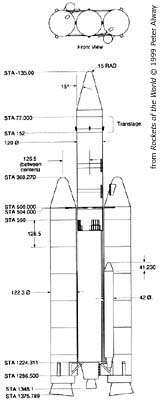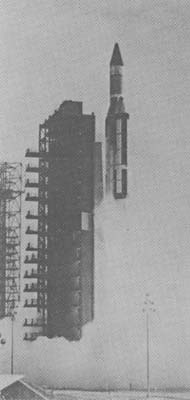Titan III C
Leafing through Rockets of the World looking for an interesting rocket to model, I came across the Titan III C (pp. 266-269). This is a cool-looking rocket, plus it has two features not often found in models: no fins, and drop-away boosters.
In 2016 we moved and all projects that had been sitting for more than five years without progress were abandoned. This one one of them.
The Pictures
The Design
See Rockets of the World, pages 266-269 for detailed plans and a discussion of the prototype rocket. If you don't have this book, you're missing out on the most valuable prototype resource in rocketry. You can order it from ARA Press. You can see the plans and a photo below. Also, check out the larger plans.

|

|
|
The first thing to do with a scale rocket is to pick a scale factor, which determines the size, or pick the size which determines the scale factor. For me, the size is dependent on what standard body tubes are available, so I'll start with that. The central airframe is 120" and the booster tanks are 122.3" in diameter. The first simplifying assumption was to make these the same in the model (the 2% difference won't be noticeable). The average of the two is 121", which will be the basis for the scale.
| diameter | scale | length | ||
|---|---|---|---|---|
| nominal I.D. | actual O.D. | sustainer | boosters | |
| 3.9" | 4.025" | 3.32% | 49.2" | 33.7" |
| 5.5" | 5.687" | 4.7% | 69.7" | 47.7" |
| 6" | 6.187" | 5.11% | 75.8" | 51.9" |
| 7.5" | 7.687" | 6.35% | 94.2" | 64.5" |
From the various samples above, you can see that this is quite a short and stubby rocket because of the boosters (only 12¼ calibers). I ended up choosing the 6.0" airframe because it made a good-sized model with plenty of space for all the mechanical parts.
Stability
A rocket without fins can't be stable, right? Wrong! Finless rockets have been built and Peter Luthi even built a "backwards-flying rocket"! (Unfortunately, his page is no longer up.) However, a rocket with no fins does require some special considerations for stability and especially this one which has the added challenge of the drop-away boosters.
Drop-Away Boosters
The drop-away boosters require some careful planning. The attachment needs to be strong enough to transmit the force of the booster motors to the sustainer, but also must detach when the boosters burn out. Here are preliminary drawings for the aft attachment and forward attachment.